NATIONAL PARK SERVICE
Park Structures and Facilities
|

|
SEATS and TABLES
AN AVERAGE of the dimensional limits of the human
frame and uniformity of a sort in the distribution of the hinges
thereof, have long since determined certain invariable dimensions for
the park seat and park table, and that conventional combination of both
which we dub herein the picnic unit. Seat surface should be 16" to 18"
and table surface 28" to 30" off the ground or floor, and for seat and
table in combination the front edge of the seat should be from 1" to 3"
removed from the edge of the table. These limiting dimensions have been
held to in practically all successful park seats and tables, and
probably in the majority of the unsuccessful ones, the differentiation
of the good from the bad resulting from varied numerous other factors,
not so easily reducible to rule.
There is great difference of opinion as to whether
picnic units fabricated of wood or laid up as masonry are the more
suitable in parks. There is lack of wisdom in any statement generalizing
on this point. The superior suitability of the one is determinable only
by application to a specific area. There are regions in which one is
more appropriate than the other, and areas as well in which both are
equally at home.
The very first decision to be made by the creator of
park furniture of wood is one around which much controversial argument
centers. To him it may be only a matter of whim, whether the seat or
table or picnic unit be built of dimensioned, commercial lumber, or of
native cut material, but he should be warned from the first that,
whichever his choice, he will be heartily condemned by approximately
fifty per cent of the arbiters of such matters.
On whichever side he may innocently and squarely
range himself, it seems only fair that he be fortified and forewarned
against all invokable arguments.
If he elects to use commercial lumber for park
furniture—
(pro) he has with commendable directness, made honest
use of the production facilities of our times to meet a strictly
utilitarian human need in all functional requirements of strength,
comfort, and economy, or,
(con) he has with unpardonable insolence, desecrated
a natural beauty spot, by the introduction of utter incongruities,
makeshift, uncompromising in line, ugly.
If he elects to fashion park furniture from native
cut timber—
(pro) he has with the skill of the true artist,
graced a natural setting with an harmonious facility, not alone of
practical usefulness, but of sturdy, handcrafted beauty, or,
(con) he has with the ruthlessness of the vandal,
felled trees that were the park's very reason for being, despoiling a
glory of nature to produce in an outworn craftsmanship, trivial
accessories that were better produced by the logical methods of today's
machines.
If, now fully apprised of the barbed horns of his
dilemma, the artisan dare to make a choice, the bench, or table, or
picnic unit may be undertaken. For his encouragement be it said that
after this choice, the further going is comparatively smooth.
If he is not himself definitely of the left or of the
right in this issue he can dare moderate scorn to win moderate approval
from the extremists of both views, and take a middle course. He can
gesture in one direction by deciding that the machine-made product is in
truth rigidly uncompromising in line, and in the other direction by
abstaining from cutting any trees within the confines of the park to
secure material for the more rugged and "freehand" pioneer crafted seats
and table. If the required "native" material can be had from some source
near at hand without sacrifice of the timber resources of the park
itself, the park furniture maker can run for a touchdown with cheering
from all sections of the stands.
Illustrated are examples of tables and seating in
wide variety. It is appreciated that differing climates, sectional
resources, and habits of use prevailing through the length and breadth
of the land, call for diversity in materials, forms, and principles, in
this necessary park equipment. Desirable as are the qualities of
sturdiness, "nativeness," woodcraft and handcraft in these minor objects
in most locations, it must be recognized that in not a few regions, a
too conscious effort to acclimate them defeats the end.
In general, it is highly desirable to discourage on
the part of patrons, the moving of picnic tables from place to place.
Dragging tables around is highly destructive of ground cover. The fixed
position, if a good one, is desirable, and is achieved by means of the
weight of the picnic unit or table, or better still, by anchoring.
There are conditions however that will dictate that
park furniture be mobile, and practical considerations requiring that it
be collapsible or knock-down for compact storage. Knock-down units
should be designed to be assembled easily, and to be as light in weight
as is consistent with the structural requirements. The fewer pieces the
better. When parts can be made interchangeable, time is not wasted in
sorting them. Cabin or screen door hook fastenings are to be preferred
to loose fastenings wherever practicable. Seat and table tops should be
of material heavy enough or braced sufficiently to avoid spring or
sag.
There are numerous practical refinements in the
construction of the picnic unit that are worthy of wide adoption.
Regardless of the quality of material and workmanship, the boards
forming the tops of wood tables will pull apart in exposure to the
weather, and more or less narrow cracks will develop between them in
which food particles are apt to lodge and are not readily removable. How
much better that the table top be constructed with open joints about
one-quarter-inch wide between the boards, from which food particles,
which do not pass through, can easily be removed.
Rough edges of seats and tables should be guarded
against. The picturesque unit of rustic wood material unfortunately will
take high toll in the tearing of silk stockings and light clothing.
The unit built of milled materials should have all
edges and roughnesses likely to come in contact with clothing or to
produce splinters, smoothed and rounded. Much can be done even to the
hand crafted type to eliminate the worst hazards without great sacrifice
of rustic character. There is a measure of defense against the use and
consequent abuse of table tops for uncapping bottles, by fastening
within a recess at the end of a heavy table top, a specific device for
this purpose.
When benches or tables are placed in fixed position,
their wood supporting members often extend into the ground. In most
instances these should be treated with creosote, tar, or other
preservative. Where the wood is western red cedar or redwood, the use of
tar or creosote is considered unnecessary. In most locations exposed
wood above ground should also be treated against weather by oiling,
shellacking, creosoting or other tried and proved methods. In the Far
West, this is not encouraged; the natural wood color is preferred and
the need for preservative treatment of the native woods held to be
unnecessary. Especially are treatments carrying color deplored and one
is quick to agree once there has been brought to his attention the
surprising number of shades of green and blue that can be bought in
paint cans, and how invariably these clash with the colors of
nature.
There are sectional preferences in tables and seating
facilities in our parks which veer away from the usual and prosaic. For
example, in California round and octagonal tables seem to meet with
favor in camp and picnic grounds. It is alleged they are more useful for
playing cards! They are usually fashioned from cross-sections of the
large redwood and fir trees available on the West Coast. But the
cross-sections split as they weather, and are far from satisfactory as
table tops. For this reason none of this type is shown in the
accompanying illustrations. Table tops in which the grain of the wood is
parallel to the top surface are longer lived.
In some localities picnic units are cleverly
contrived combinations of wood and stone, in others they are built
entirely of native stone. It is possible that tables and seating built
wholly or in part of rock blend into some landscapes more readily than
do those of logs or sized lumber. They may have advantages, practical
and aesthetic, but are permanent to a fault that no end of good points
can offset. The stone picnic table, by reason of its immobility and
durability, defeats itself. The picnic ground is an area of intensive
use, its equipment subject to hard wear. It may seem far sighted to
create picnic units of stone because these will stand the gaff over a
long period. They meet abundantly this requirement, but their potential
life is hardly begun before the site, especially the average picnic
site, has lost most of its value as a natural area due to concentrated
use, and must be evacuated and left to the healing processes of Nature.
The most cumbersome wood picnic unit could be moved under these
conditions, but not the stone unit. Ergo, the stone unit, through no
frailty of its own, is in "dry dock," and the capital investment therein
"omits the dividend" for the duration of the site's recuperative
period.
There are other less formidable factors militating
against the use of masonry tables and benches. They are executed with
great difficulty, because, due to the freehand lines desired, workmen
find it hard to construct them from a blueprint with a nice balance of
freedom and accuracy. The units should be located in almost permanent
shade since otherwise they become thoroughly heated and radiate heat for
a long period. Furthermore only the smoothest stone slabs serve
satisfactorily as table tops, and these are not always readily
obtainable. Cement slab tops in substitution seldom, if ever, give a
satisfactory appearance. Because only a broad base looks reasonable for
supporting a stone slab table top, there is danger of interference with
leg room.
It would seem reasonable that the informality which
is the very spirit of picnicking could be played up to by varying the
standardized table and bench combination. In the direction of novelty is
an arrangement of naturalized stone table serving as a buffet in the
shade near the fireplace with seats ranged informally round about
through clever naturalizing of boulders, flat rocks or large logs, or
exposing of natural rock outcroppings.
There are park reservations where the forest cover is
limited or the rainfall unusually heavy, and wherein picnic area
developments are properly located by reason of other governing dictates
than shade. In such instances, picnic units logically include a
sheltering roof, or perhaps even require a windbreak against prevalent
high winds. Any complication of function tending to increase the size of
objects which are desirably kept as inconspicuous as possible, is
unfortunate, but form must ever follow demonstrated need.
So much for picnic tables and benches in connection
with them. There are other needs for seating within our natural parks,
of more or less casual nature. Particularly along trails are
opportunities offered for the resourceful utilization of natural objects or
formations as resting places. A ledge of stone, a stump cut and hollowed
out to form a seat, and boulders or down logs with slight adaptations
provide trailside seating without the introduction of foreign elements.
Two stumps in suitable proximity provide supports for split log as a
resting place. A huge fallen log is notched to provide seat and back.
Almost invariably, an ingenious collaboration with Nature provokes more
genuine acclaim than the more pretentious object of which man can claim
sole authorship.
With trailside seats on occasion, as with picnic
tables, there is tendency in certain areas to elaborate the simple unit
into something in the nature of a minor shelter, that makes
classification as seat or shelter somewhat difficult to decide.
In truth, the dividing line is drawn with difficulty
and perhaps without pure logic as a perusal of the illustrations under
both classifications may demonstrate. It is surely sound to urge for
such glorifications of the simple bench, and of the picnic unit as well,
a heightening of quality, somehow consistent with their size and
pretentions. If a higher quality means a lesser quantity of these
pretentious objects, it is still a good rule to follow.

|
|
Plate G-1 (click on image for a PDF version)
|
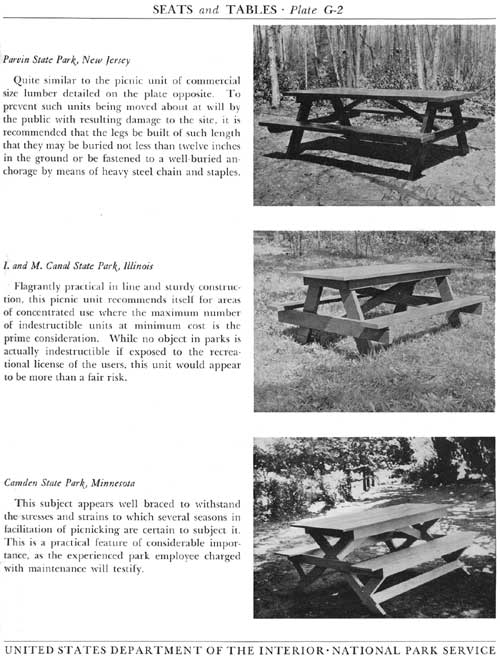
|
|
Plate G-2 (click on image for a PDF version)
|
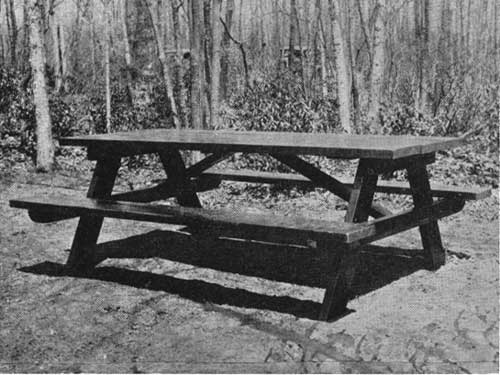
|
Parvin State Park, New Jersey
Quite similar to the picnic unit of commercial size
lumber detailed on the plate opposite. To prevent such units being moved
about at will by the public with resulting damage to the site, it is
recommended that the legs be built of such length that they may be
buried not less than twelve inches in the ground or be fastened to a
well-buried anchorage by means of heavy steel chain and staples.
|
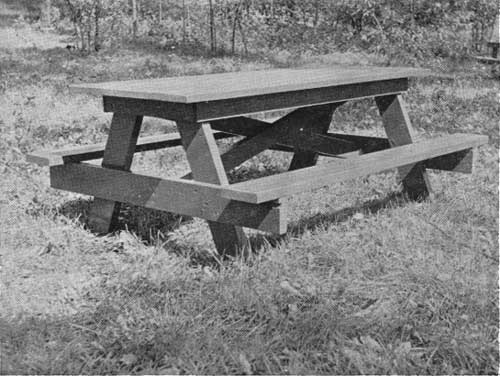
|
I. and M. Canal State Park, Illinois
Flagrantly practical in line and sturdy construction,
this picnic unit recommends itself for areas of concentrated use where
the maximum number of indestructible units at minimum cost is the prime
consideration. While no object in parks is actually indestructible if
exposed to the recreational licens the users, this unit would appear
to be more than a fair risk.
|
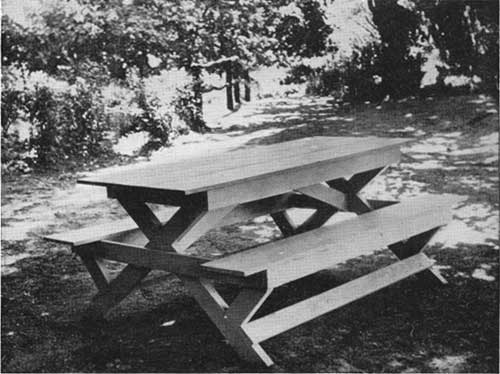
|
Camden State Park, Minnesota
This subject appears well braced to withstand the
stresses and strains to which several seasons in facilitation of
picnicking are certain to subject it. This is a practical feature of
considerable importance, as the experienced park employee charged with
maintenance will testify.
|
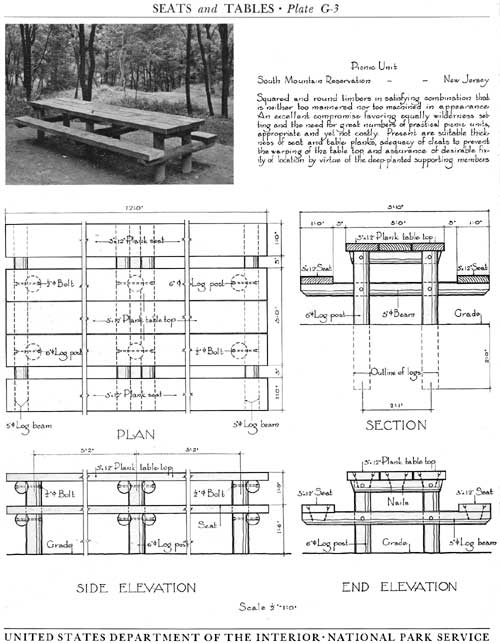
|
|
Plate G-3 (click on image for a PDF version)
|
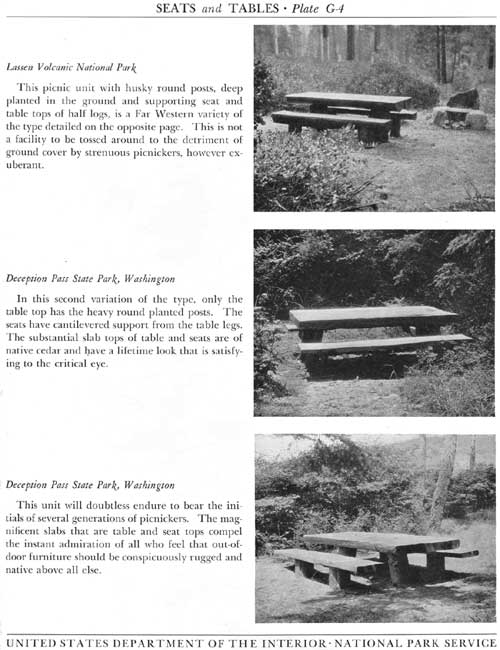
|
|
Plate G-4 (click on image for a PDF version)
|
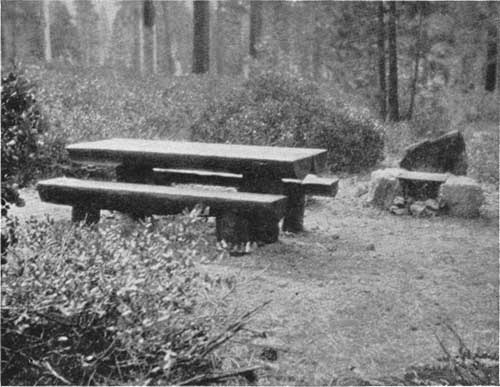
|
Lassen Volcanic National Park
This picnic unit with husky round posts, deep planted
in the ground and supporting seat and table tops of half logs, is a Far
Western variety of the type detailed on the opposite page. This is not a
facility to be tossed around to the detriment of ground cover by
strenuous picnickers, however exuberant.
|
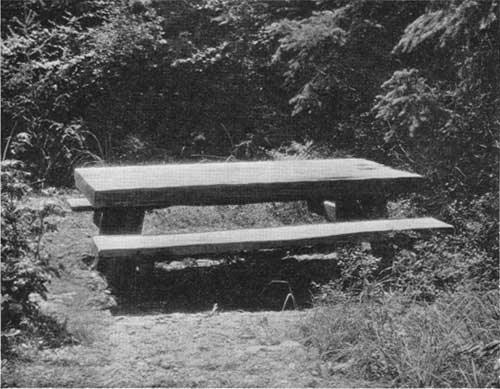
|
Deception Pass State Park, Washington
In this second variation of the type, only the table
top has the heavy round planted posts. The seats have cantilevered
support from the table legs. The substantial slab tops of table and
seats are of native cedar and have a lifetime look that is satisfying to
the critical eye.
|

|
Deception Pass State Park, Washington
This unit will doubtless endure to bear the initials
of several generations of picnickers. The magnificent slabs that are
table and seat tops compel the instant admiration of all who feel that
out-of door furniture should be conspicuously rugged and native above
all else.
|
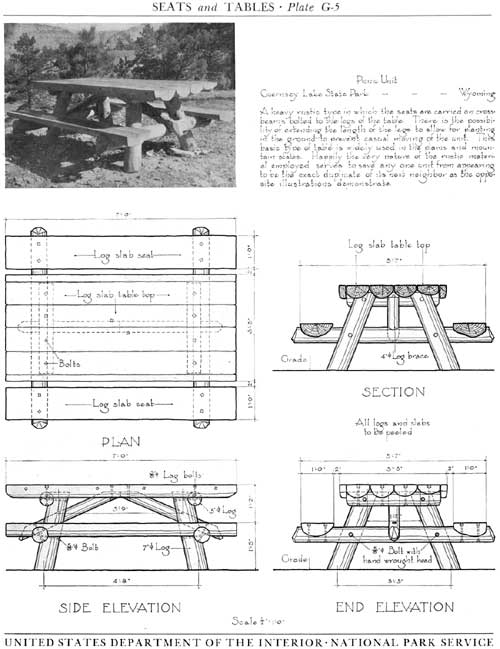
|
|
Plate G-5 (click on image for a PDF version)
|
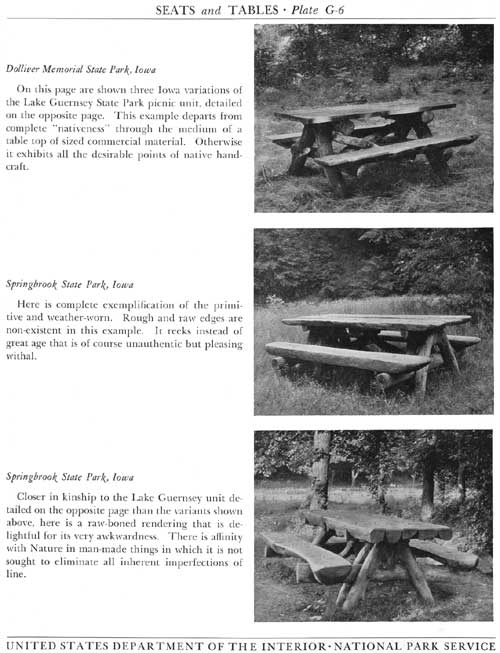
|
|
Plate G-6 (click on image for a PDF version)
|
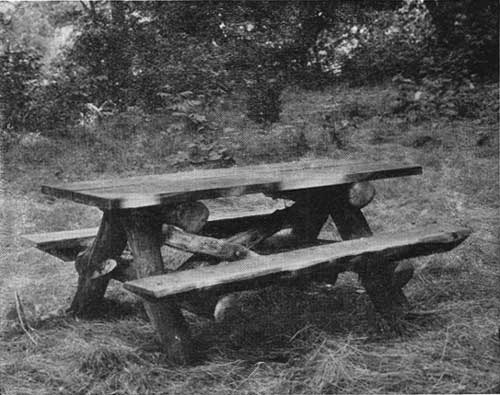
|
Dolliver Memorial State Park, Iowa
On this page are shown three Iowa variations of the
Lake Guernsey State Park picnic unit, detailed on the opposite page.
This example departs from complete "nativeness" through the medium of a
table top of sized commercial material. Otherwise it exhibits all the
desirable points of native hand-craft.
|

|
Springbrook State Park, Iowa
Here is complete exemplification of the primitive and
weather-worn. Rough and raw edges are non-existent in this example. It
reeks instead of great age that is of course unauthentic but pleasing
withal.
|

|
Springbrook State Park, Iowa
Closer in kinship to the Lake Guernsey unit detailed
on the opposite page than the variants shown above, here is a raw-boned
rendering that is delightful for its very awkwardness. There is affinity
with Nature in man-made things in which it is not sought to eliminate
all inherent imperfections of line.
|

|
|
Plate G-7 (click on image for a PDF version)
|
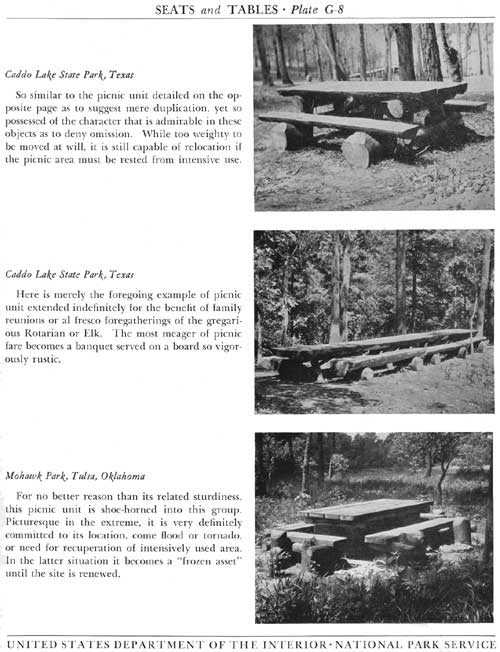
|
|
Plate G-8 (click on image for a PDF version)
|
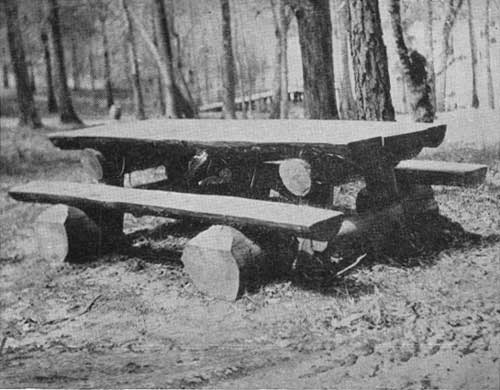
|
Caddo Lake State Park, Texas
So similar to the picnic unit detailed on the
opposite page as to suggest mere duplication, yet so possessed of the
character that is admirable in these objects as to deny omission. While
too weighty to be moved at will, it is still capable of relocation if
the picnic area must be rested from intensive use.
|
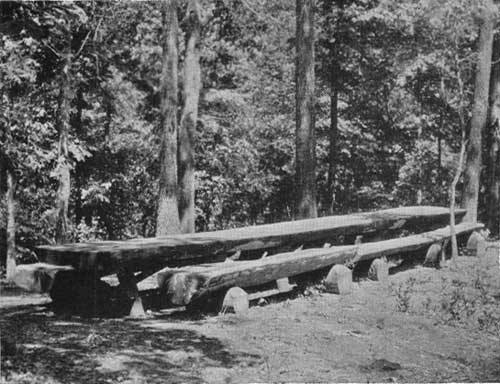
|
Caddo Lake State Park, Texas
Here is merely the foregoing example of picnic unit
extended indefinitely for the benefit of family reunions or al fresco
foregatherings of the gregarious Rotarian or Elk. The most meager of
picnic fare becomes a banquet served on a board so vigorously
rustic.
|
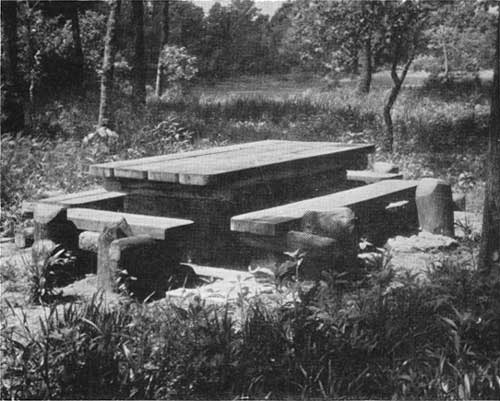
|
Mohawk Park, Tulsa, Oklahoma
For no better reason than its related sturdiness,
this picnic unit is shoe-horned into this group. Picturesque in the
extreme, it is very definitely committed to its location, come flood or
tornado, or need for recuperation of intensively used area. In the
latter situation it becomes a "frozen asset" until the site is
renewed.
|
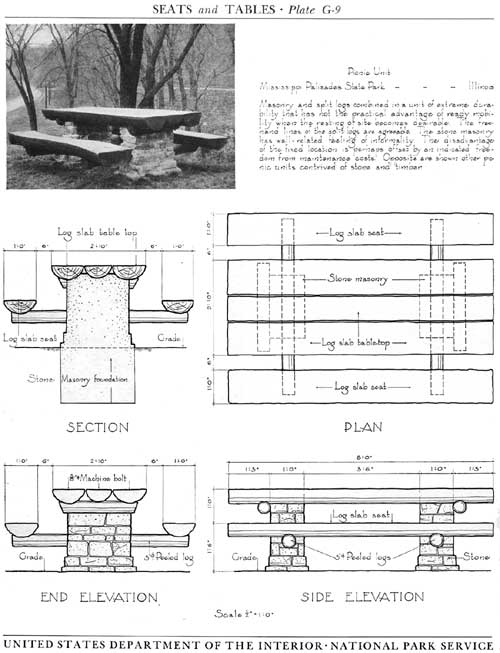
|
|
Plate G-9 (click on image for a PDF version)
|
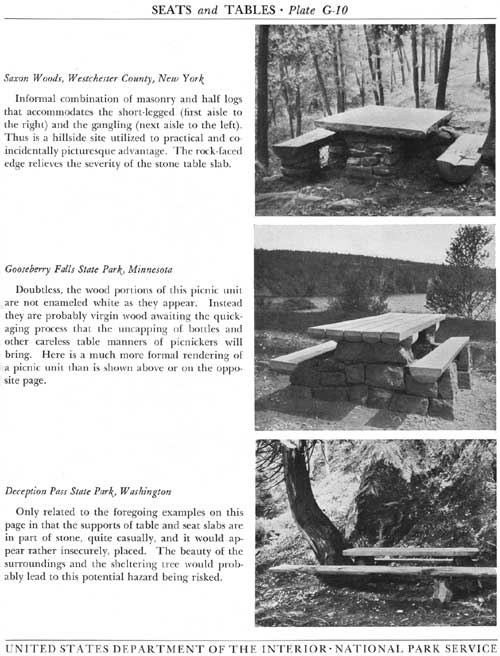
|
|
Plate G-10 (click on image for a PDF version)
|
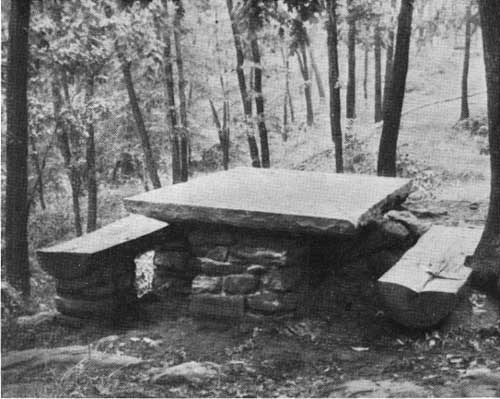
|
Saxon Woods, Westchester County, New York
Informal combination of masonry and half logs that
accommodates the short-legged (first aisle to the right) and the
gangling (next aisle to the left). Thus is a hillside site utilized to
practical and coincidentally picturesque advantage. The rock-faced edge
relieves the severity of the stone table slab.
|
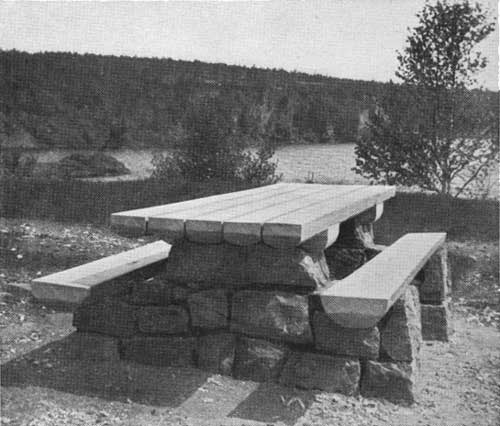
|
Gooseberry Falls State Park, Minnesota
Doubtless, the wood portions of this picnic unit are
not enameled white as they appear. Instead they are probably virgin wood
awaiting the quick-aging process that the uncapping of bottles and other
careless table manners of picnickers will bring. Here is a much more
formal rendering of a picnic unit than is shown above or on the opposite
page.
|
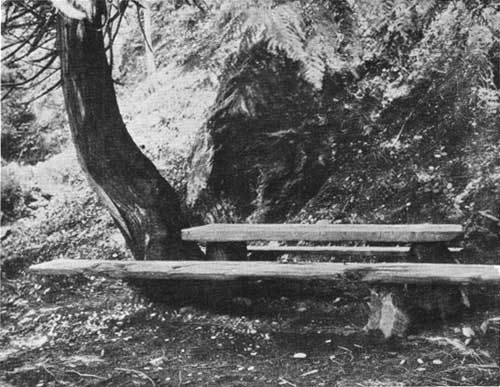
|
Deception Pass State Park, Washington
Only related to the foregoing examples on this page
in that the supports of table and seat slabs are in part of stone, quite
casually, and it would appear rather insecurely, placed. The beauty of
the surroundings and the sheltering tree would probably lead to this
potential hazard being risked.
|
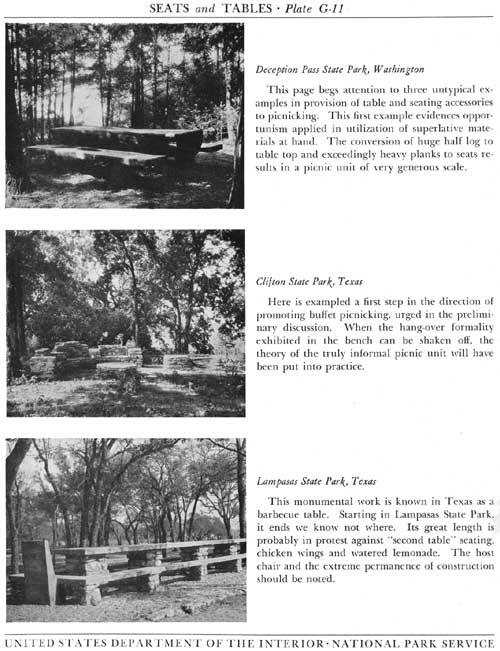
|
|
Plate G-11 (click on image for a PDF version)
|
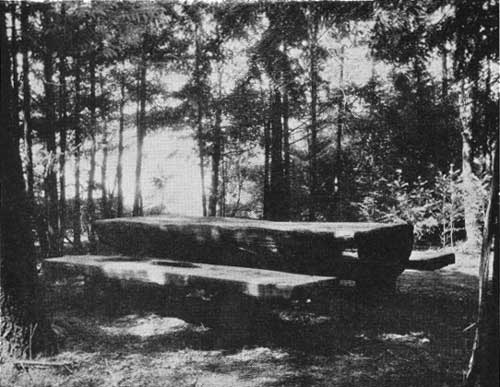
|
Deception Pass State Park, Washington
This page begs attention to three untypical examples
in provision of table and seating accessories to picnicking. This first
example evidences opportunism applied in utilization of superlative
materials at hand. The conversion of huge half log to table top and
exceedingly heavy planks to seats results in a picnic unit of very
generous scale.
|
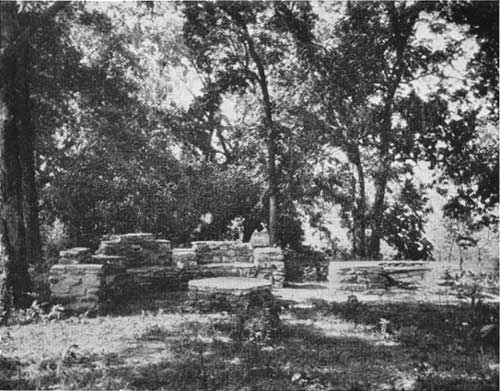
|
Clifton State Park, Texas
Here is exampled a first step in the direction of
promoting buffet picnicking, urged in the preliminary discussion. When
the hang-over formality exhibited in the bench can be shaken off, the
theory of the truly informal picnic unit will have been put into
practice.
|
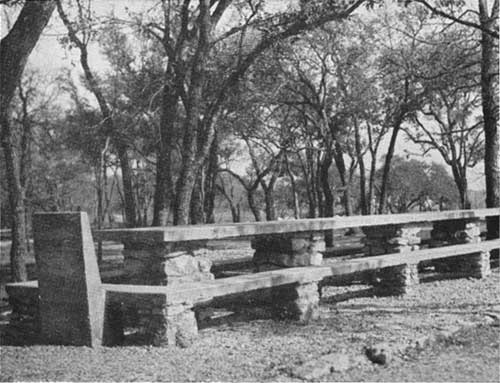
|
Lampasas State Park, Texas
This monumental work is known in Texas as a barbecue
table. Starting in Lampasas State Park, it ends we know not where. Its
great length is probably in protest against "second table" seating,
chicken wings and watered lemonade. The host chair and the extreme
permanence of construction should be noted.
|

|
|
Plate G-12 (click on image for a PDF version)
|
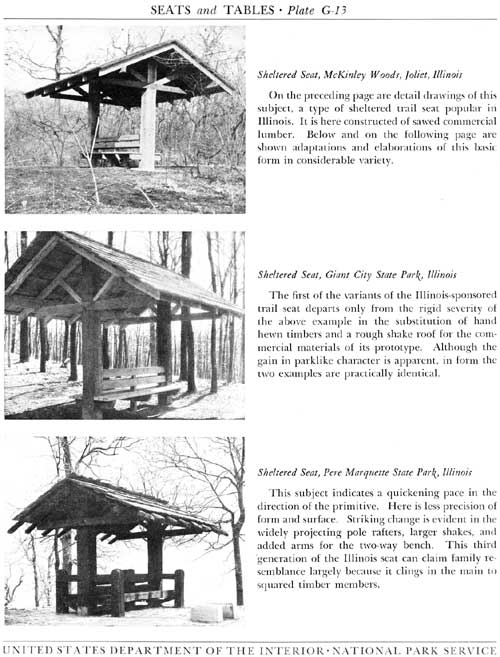
|
|
Plate G-13 (click on image for a PDF version)
|
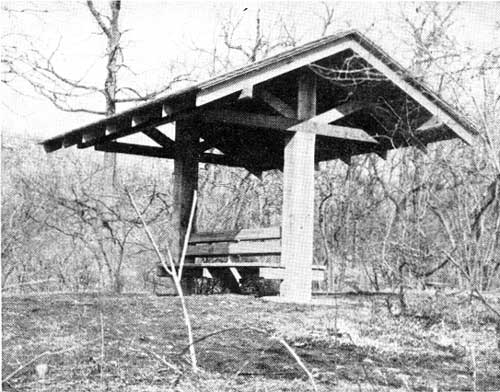
|
Sheltered Seat, McKinley Woods, Joliet, Illinois
On the preceding page are detail drawings of this
subject, a type of sheltered trail seat popular in Illinois. It is here
constructed of sawed commercial lumber. Below and on the following page
are shown adaptations and elaborations of this basic form in
considerable variety.
|
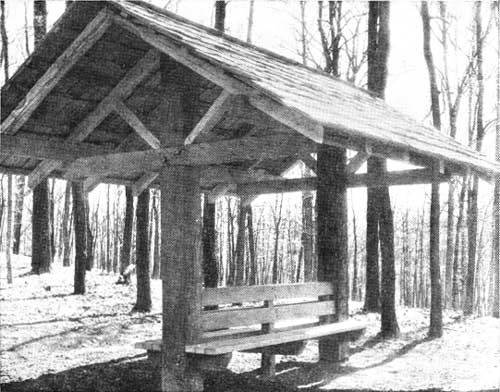
|
Sheltered Seat, Giant City State Park, Illinois
The first of the variants of the Illinois-sponsored
trail seat departs only from the rigid severity of the above example in
the substitution of hand hewn timbers and a rough shake roof for the
commercial materials of its prototype. Although the gain in parklike
character is apparent, in form the two examples are practically
identical.
|

|
Sheltered Seat, Pere Marquette State Park, Illinois
This subject indicates a quickening pace in the
direction of the primitive. Here is less precision of form and surface.
Striking change is evident in the widely projecting pole rafters, larger
shakes, and added arms for the two-way bench. This third generation of
the Illinois seat can claim family resemblance largely because it clings
in the main to squared timber members.
|

|
|
Plate G-14 (click on image for a PDF version)
|

|
Sheltered Seat, Marseilles State Park, Illinois
Something of a throwback in this fable of family tree
to the example that here stands as its grandfather. There is a mere
vestige of the lately added arms, and the recent shagginess of shake
roof is missing. Only the use of round timber members practically
throughout evidences that change has not come to a full stop. There are
those who will claim that the strain reaches its zenith in the member
here pictured.
|
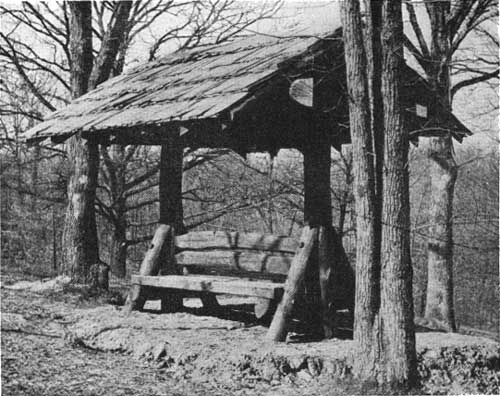
|
Sheltered Seat, New Salem State Park, Illinois
Here is acceleration of variety not unmixed with
faint trace of decadence of a fine old stock. The supporting posts lack
the robustness of the ancestral line, but, as if to compensate for this,
are fortified structurally with braces to the ground. This feature is
not unpleasing and instances again the tendency to supply some kind of
arm to the bench. The roof reverts to the ragged informality but one
generation removed. Eventual remoulding of the existing grade around
this seat will supply a more favorable setting.
|

|
Sheltered Seat, New Salem State Park, Illinois
Four supporting posts in place of two, the roof ridge
at right angles to that of all foregoing examples, and the family traits
are all but lost. This last of the line can still claim a roof covering
that is in character and framing members that are adequate in size. The
arms have been developed to great prominence. Simple directness that
heretofore distinguished the type has now become so vague that further
pursuit of this study in evolution would be without point.
|
Trailside Seats
Ranging from half log on stone or post supports
through benches with several varieties of back, and finally to one that
incorporates a directional sign, here is run the gamut of simple
trailside seats. Benches elaborate and sophisticated beyond the
limitations of the examples here grouped have less measure of
justification in natural parks. The surrounding types are capable of
infinite variation giving scope for wide differences in detail without
violation of reasonable simplicity. It will be observed that a happy
choice of location for the seat or bench plays no small part in the
effect created.

|
|
Plate G-15 (click on image for a PDF version)
|
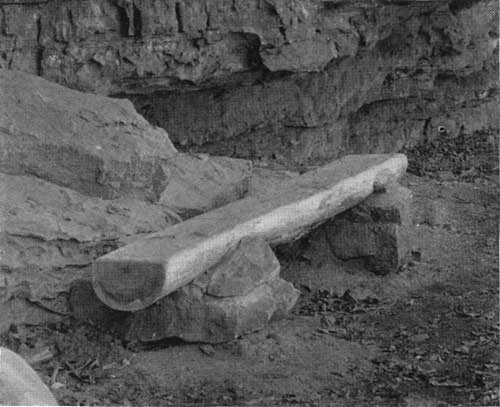
|
|
Giant City State Park, Illinois
|
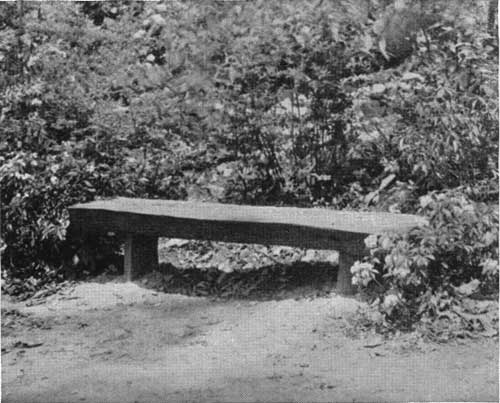
|
|
Mt. Penn State Park, Reading, Pennsylvania
|
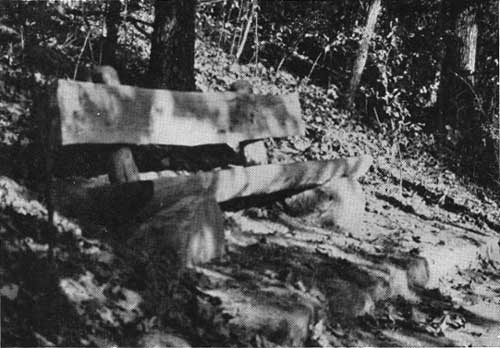
|
|
New Salem State Park, Illinois
|
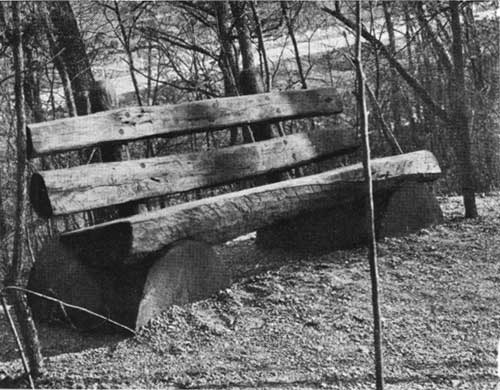
|
|
New Salem State Park, Illinois
|

|
|
Wells State Park, Michigan
|

|
|
Plate G-16 (click on image for a PDF version)
|
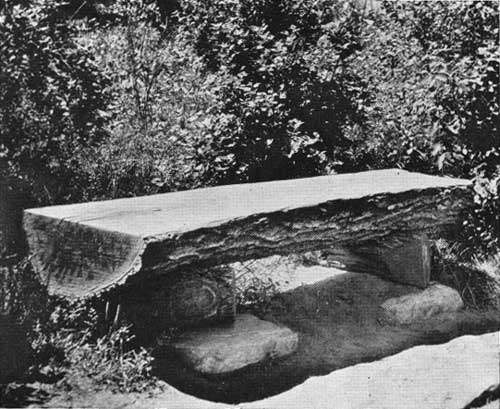
|
|
Camden State Park, Minnesota
|
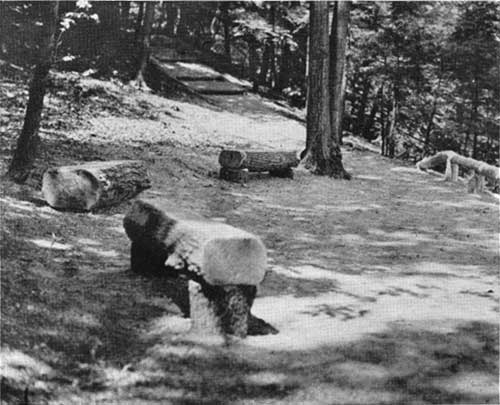
|
|
Letchworth State Park, New York
|

|
|
Wells State Park, Michigan
|
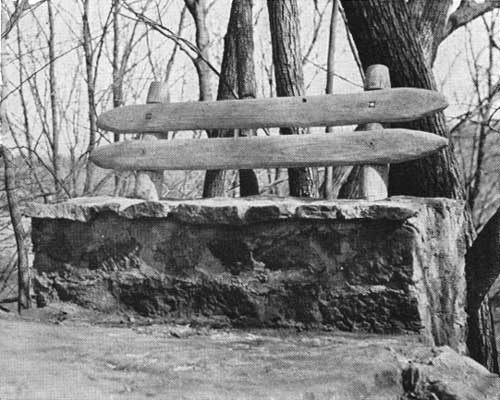
|
|
Dolliver Memorial State Park, Iowa
|
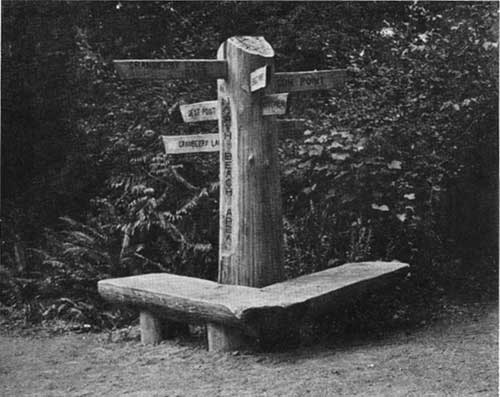
|
|
Deception Pass State Park, Washington
|
Seats in Iowa State Parks
Variety and individuality have been brought to the
seats and benches created for the furnishing of shelters and for outdoor
locations in the State Parks of Iowa. There is a quality of naive
handcraftedness about the surrounding examples that cannot but command
interest, if failing unqualified approval. From simple seat hewn from a
log to complicated fabricated bench with back is a colorful vocabulary
of seating furniture. The same primitive note that pervades the benches
is to be found in the picnic tables shown within this section, and both
in turn relate well to the characteristic shelters in Iowa parks.
Typical Iowa shelters are shown elsewhere herein.
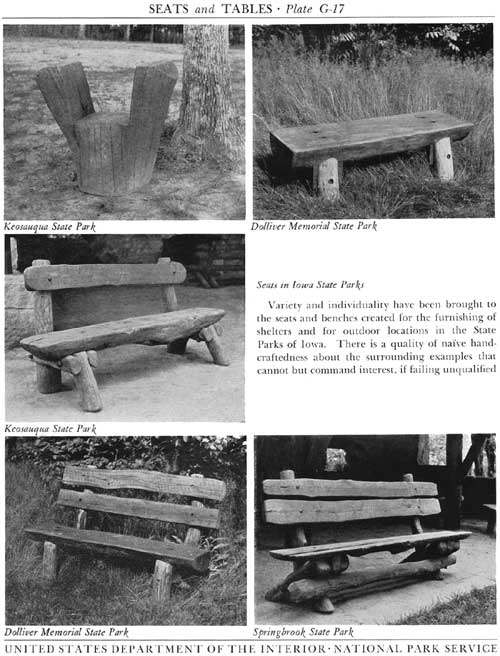
|
|
Plate G-17 (click on image for a PDF version)
|
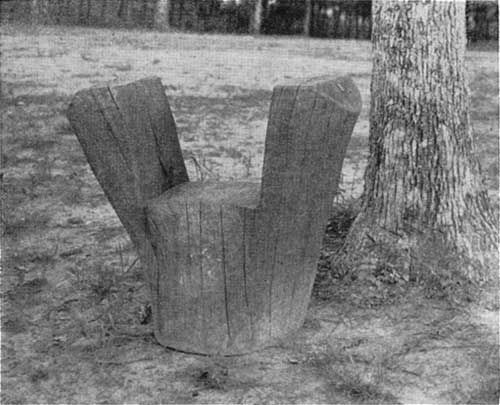
|
|
Keosauqua State Park
|
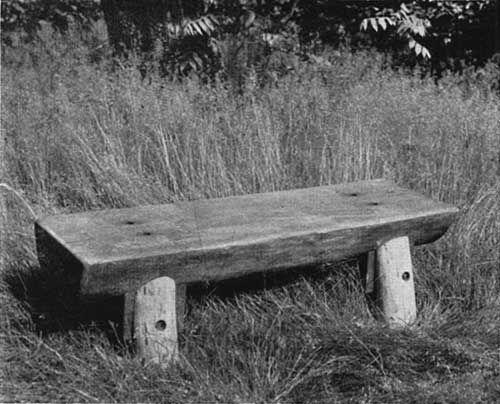
|
|
Dolliver Memorial State Park
|
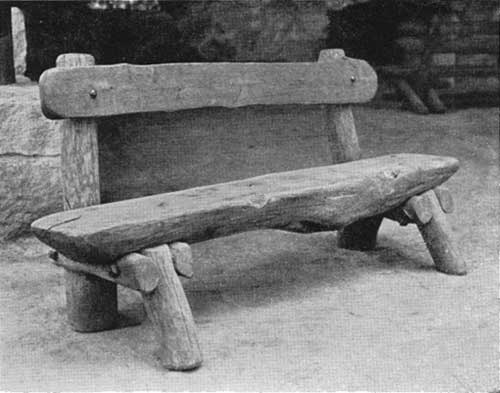
|
|
Keosauqua State Park
|
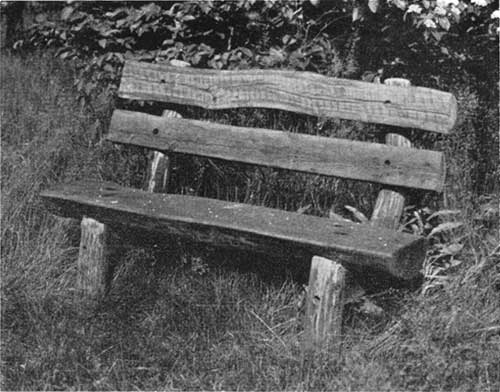
|
|
Dolliver Memorial State Park
|

|
|
Springbrook State Park
|
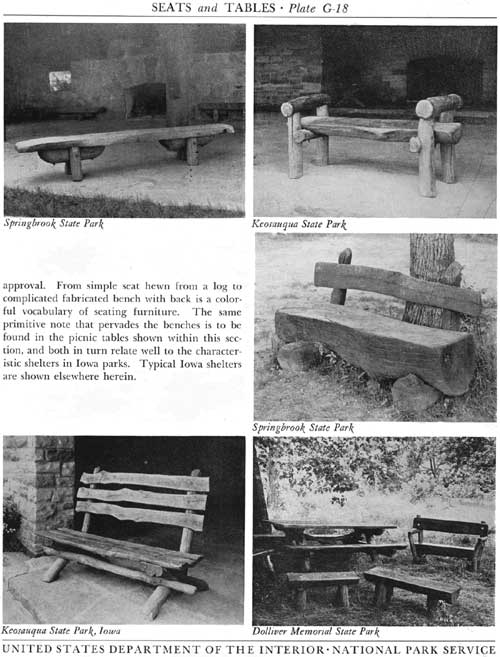
|
|
Plate G-18 (click on image for a PDF version)
|
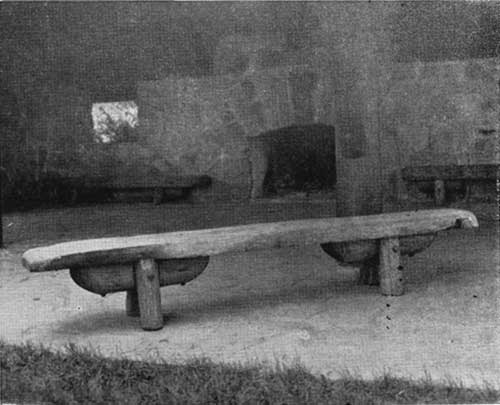
|
|
Springbrook State Park
|
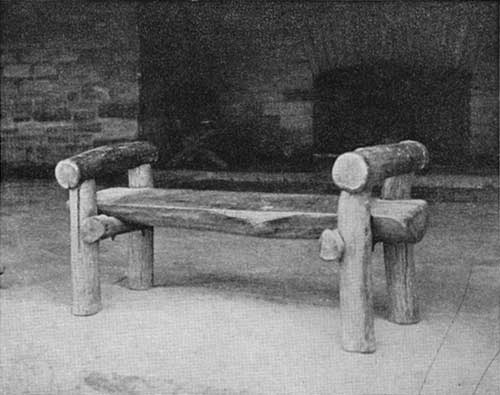
|
|
Keosauqua State Park
|
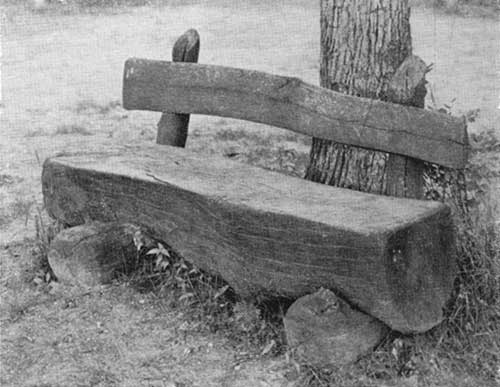
|
|
Springbrook State Park
|
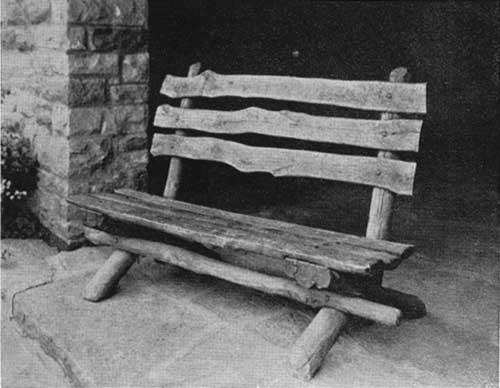
|
|
Keosauqua State Park, Iowa
|
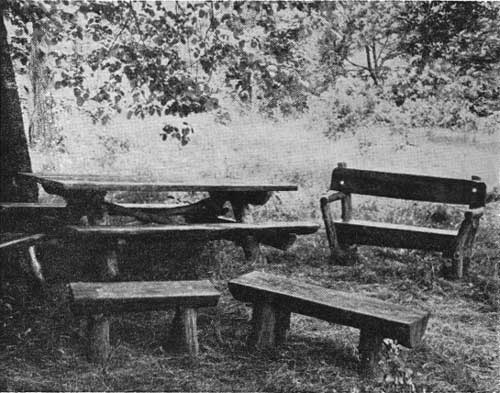
|
|
Dolliver Memorial State Park
|
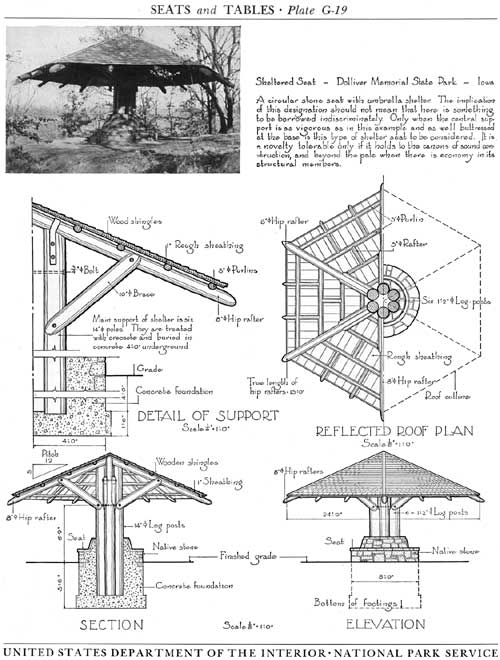
|
|
Plate G-19 (click on image for a PDF version)
|
park_structures_facilities/secg.htm
Last Updated: 5-Dec-2011
|































































